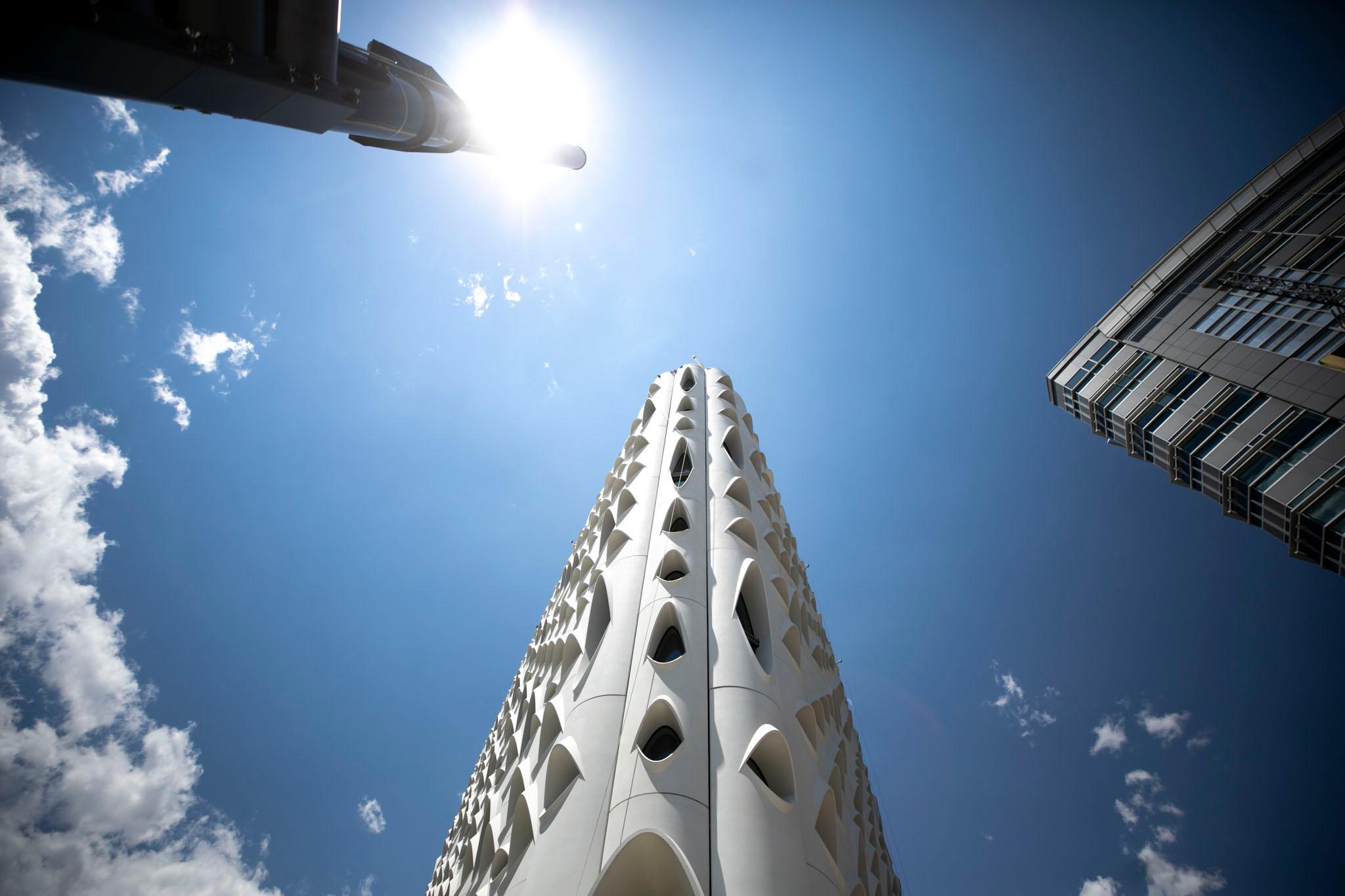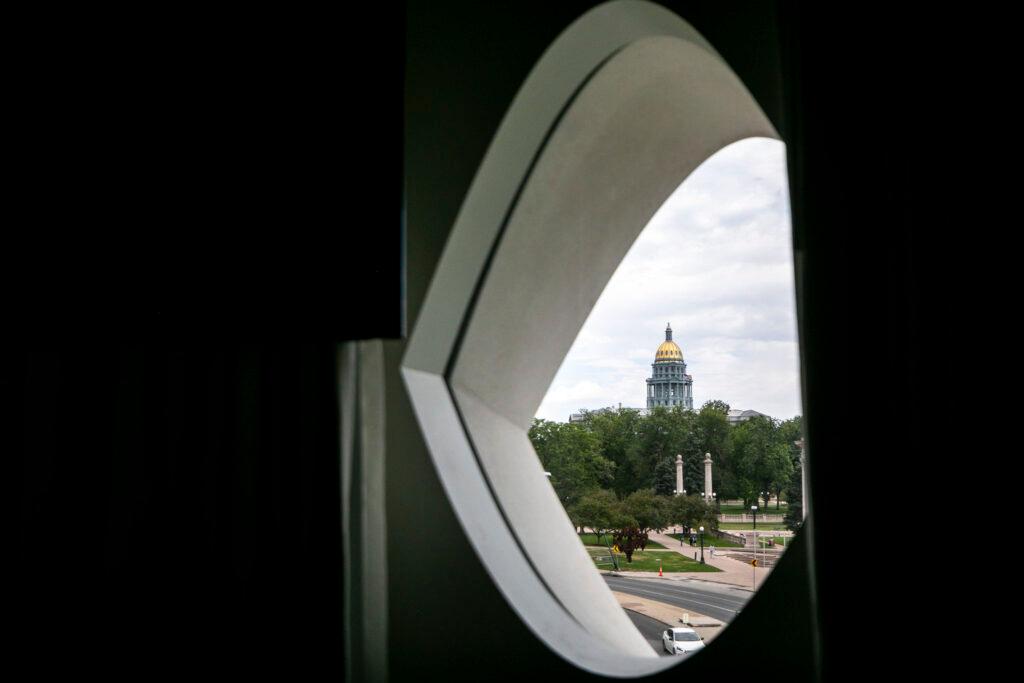
Populus, a new eco-friendly hotel in downtown Denver, doesn't just invite guests to stay in a hotel designed to resemble an aspen tree.
The creators of the striking 13-story tower, which opened last week, have promised the project will mimic the environmental benefits of a sapling. Through a commitment to eco-friendly practices and investments in off-site projects, the backers claim the development will remove greenhouse gases from the atmosphere over time, putting it on track to become the “first carbon-positive hotel in the U.S.”
It’s a bold assertion given recent estimates suggest real estate accounts for nearly 40 percent of global greenhouse gas emissions. Jon Buerge, the president of Urban Villages and the lead developer behind Populus, is well aware of those statistics, and he hopes the new hotel sets a higher standard for builders around the world.
“We feel a responsibility to deal with that,” he told CPR News in July.
To minimize the overall carbon impact of the project, the hotel backers opted against any onsite parking to cut down on carbon-intensive cement and reinforced steel. Materials like low-carbon concrete and upcycled snow fences built into the ceilings helped further shrink the environmental footprint. Studio Gang, a world-renowned architecture firm headquartered in Chicago, designed the “lids” of the distinctive eye-shaped windows to shade interior spaces and conserve energy.
The hotel also purchases 100 percent renewable electricity, its restaurants source food from regional regenerative and organic farms, and all of the hotel’s food waste will be composted, Buerge said.

The Colorado State Capitol seen from Denver's new Populus Hotel, July 9, 2024. 
A room in Denver's Populus Hotel, July 9, 2024.

Urban Villages, however, has never suggested that the hotel would lock away carbon on its own. The plan was always to improve upon a common corporate climate strategy: investing in offsite projects to draw down emissions elsewhere.
That’s how the hotel ended up supporting a project to plant tens of thousands of Engelmann spruce trees more than 200 miles away near Gunnison, Colo. Urban Villages estimated those young trees plus additional investments in regenerative agriculture projects would recoup emissions released during the construction process four to five times over.
Populus has also committed to planting a tree in Colorado’s national forests for every night a guest stays in the hotel, which is meant to help recover emissions released by operating a 265-room luxury lodging option with natural gas heating and two onsite restaurants.

It appears, however, that the initial plan to fulfill the hotel’s “carbon-positive” promise has hit a speed bump. A September visit to the Populus hotel’s tree-planting site with its lead forester suggested the seedlings struggled during the following winter and a later drought. Afterward, Brittany Perrin, a U.S. Forest Service spokesperson with Grand Mesa, Uncompahgre and Gunnison National Forests, said a survey a year after the planting project found nearly 80 percent of the seedlings were dead — higher than the average 46 percent mortality rate for Engelmann spruce seedlings in the Gunnison Ranger District.
But Buerge insists the situation doesn’t undermine the hotel’s climate commitments. From the beginning, he said tree-planting was one piece of a long-term and flexible strategy to offset emissions, and the hotel is now adjusting course after the initial project failed to meet expectations.
A plan to cancel emissions in struggling forests
Denver’s newest hotel is far from the first private enterprise to count on trees to clean up climate pollution. Major corporations have spent decades trying to cancel their carbon footprints by planting trees or protecting ecosystems believed to absorb atmospheric carbon pollution into soil or plant tissue.
While many forests are effective carbon sinks, tree planting is far from a sure bet for companies trying to offset their climate-warming emissions. Recent investigative reports and academic studies about some of these programs — broadly described as carbon sequestration projects or carbon credits — have found many fail to deliver real emissions reductions due to incorrect sequestration estimates. In other cases, disruptions like wildfires can devastate forests that are expected to absorb emissions for decades.
After committing to offset the hotel’s emissions, Buerge said his company considered buying “certified carbon credits” verified by third parties, but it decided investments in far-flung projects carried too much risk and uncertainty. To avoid the pitfalls, the hotel opted to work directly with nonprofits to plant trees on national forest lands in Colorado. In July, Buerge said that approach would allow the hotel to more easily monitor the trees’ health and help the guests understand threats facing the state’s natural environment.
“We felt it was necessary and important to invest in our own backyard. We wanted our carbon sequestration strategies to be local. We wanted to be able to connect with them,” Buerge said.
To account for emissions related to the hotel’s construction, the developers paid around $60,000 to invest in a project to help the U.S. Forest Service to plant more than 77,000 Engelmann spruce trees on 254 acres heavily damaged by beetles, according to a partnership agreement CPR News obtained through a public records request.

One Tree Planted, a leading global tree-planting charity, brokered the deal between the U.S. Forest Service and the hotel. Matthew Jeffery, the chief programs officer for the nonprofit, said the arrangement came together after his organization paid the U.S. Forest Service to cover the cost of seedlings for a 2022 planting project south of Gunnison. The investment from the hotel developer then compensated his organization for part of those expenses.
“This is a process,” Jeffery explained. “We're working with the Forest Service to help restore national forest lands. We invest in projects and then fundraise around them.”
The nonprofit did not estimate how much carbon the trees would pull from the atmosphere. In a July interview, Jack Coble, the vice president of design and environmental stewardship for Urban Villages, said an environmental consultant hired by the hotel developer estimated the Engelmann spruce trees would sequester about 13,000 metric tons of carbon over the lifetime of the trees — roughly twice the amount released by the hotel’s construction.
CPR News has not examined the calculations behind those estimates, but any benefit depends on the seedlings growing into mature spruce trees. A recent trip to the planting site, however, raises doubts about whether those young seedlings have survived their first two years in the Rocky Mountains.
A trip to the tree-planting site
The task of overseeing the project belongs to Arthur Haines, a U.S. Forest Service silviculturist working for the Gunnison Ranger District.
Haines first took a job as a federal forester in 1981. Since then, he's managed countless logging and tree-planting projects in the rolling mountains below San Luis Peak, one of Colorado’s prominent 14ers. The region is beloved by hunters looking for elk and deer known to thrive in the patchwork of broad meadows and tree groves.
On an afternoon in late September, Haines drove his white Dodge Ram pickup through forests devastated by a spruce beetle outbreak that began in 2011. Thousands of mature trees blackened by the pests now loom over healthy aspen trees and younger spruces and firs.
“It was just a tsunami wave that gobbled up our high-elevation spruce forests all the way up this mountain range,” Haines said.

A 2022 federal aerial survey shows spruce beetles have affected nearly two million acres of Colorado forests. While the insects aren’t invasive, researchers say recent drought conditions linked to climate change have left the trees more susceptible to pests.
The U.S. Forest Service responded by allowing timber companies to clear beetle-killed trees in some places, which Haines said salvages valuable lumber and reduces potential wildfire fuel. If spruce trees don’t naturally recolonize those areas, the federal government then plants trees to help restore the forest.
Over the last nine years, the process has helped reseed Engelmann spruce trees across more than 3,500 acres in the Gunnison Ranger District, according to a U.S. Forest Service spokesperson. In general, those plantings have a 54 percent survival rate after two years, but particular areas often experience higher mortality rates due to drought or poor weather conditions.
The current state of the tree-planting project
Haines said both factors led to serious problems at the tree-planting site financed by Populus.
Due to a severe worker shortage in 2022, the seedlings went into the ground in late August, leaving them just a few weeks to mature before experiencing frost and cold weather. Dry conditions the following year further imperiled the young trees, Haines said.
“They broke buds and started to grow, but they got frosted immediately, so almost 100% mortality this year,” Haines said, pointing out a skeletal seedling tucked behind a log. “We’re not very pleased or proud of it.”

After CPR News shared concerns about the project with Urban Villages, the developer sent a team to inspect the tree-planting site in late September. Buerge, the company’s president, later sent an email showing photos of healthy saplings in the area. He added that some were next to shade cards used to protect young seedlings, suggesting that the trees had been planted rather than naturally seeded.
Brittany Perrin, the Forest Service spokesperson, said a survey conducted in the fall of 2023 found about 20 percent of the planted trees were still alive. The federal government will conduct a full survey in 2025 to determine whether the project’s survival rates meet forest restoration objectives. If those goals aren’t met, the area will be re-evaluated to determine additional planting needs.
Buerge said it’s unfair to judge the overall success of the tree-planting project until then. If the seedlings haven’t taken root and the project is deemed unsuccessful, he said Urban Villages will find other ways to fulfill the hotel’s climate commitments.
An expanded plan to offset carbon emissions
While the hotel backers aren’t ready to call the project near the La Garita Wilderness a failure, they’ve adjusted their climate strategy following the Forest Service’s initial assessments.
On Oct. 14, Urban Villages announced it had purchased additional carbon offsets a day before the hotel’s official opening. In a press release, the developer said it acquired “forest and soil” certified carbon credits to sequester an estimated 7,000 metric tons of carbon, enough to offset emissions related to the hotel’s construction.
Buerge explained the decision on a recent morning inside the newly opened lobby, which was buzzing with guests and other customers sipping drinks from the hotel coffee shop.
He acknowledged the initial tree-planting project had a higher mortality rate than expected. In response, he said his company re-examined the possibility of buying certified carbon credits to offset its construction emissions and concluded the team had more confidence in those options than paying to plant more seedlings.
“When you're planting new trees through One Tree Planted or other sources, it’s not a guarantee, and so this was a really appealing thing to us,” Buerge said. “We know that we have supported efforts that have sequestered enough carbon to offset our embodied carbon footprint.”

The credits purchased by Populus include investments in efforts to maintain healthy forests in Vermont and Massachusetts. Other projects in the suite of new credits protect forests on private property in North Carolina slated for “conversion” — a broad term that describes replacing a natural forest with crops or other kinds of land use. In addition, Populus bought credits from Grassroots Carbon, a company partnering with ranchers to restore healthy grasslands.
Populus also remains committed to supporting tree planting to help offset emissions related to its ongoing operations. The National Forest Foundation, another nonprofit backing tree-planting projects, will facilitate the hotel’s “one night, one tree” program, which will cover the cost of seedlings the U.S. Forest Service plans to plant in Colorado’s Grand Mesa, Uncompahgre, and Gunnison National Forests and the White River National Forest, Buerge said.
He expects some of those planting projects also won’t succeed. That’s why his team now plans to inspect its various tree-planting efforts on a quarterly basis. “We're not going to send capital to the U.S. Forest Service and then expect that everything's going to go correctly. We've got to verify that,” Buerge said.
Haines agrees there’s little guarantee that any seedling will survive into a fully grown tree. On the drive out of the original tree-planting site, the forest manager admitted that’s partially why he’s uncomfortable with anyone claiming his work could erase the climate impact of construction projects or other industrial activities.
From his experience, maintaining healthy forests just involves too much uncertainty.
“It’s just marketing, basically, and I don’t trust the numbers enough,” Haines said.








